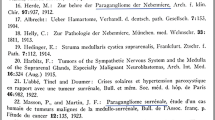Summary
Secretory glycoconjugates in the epithelium of the goat prostate were investigated with various electron microscopical histochemical methods that involved periodic acid—thiocarbohydrazide—silver proteinate, colloidal gold-labelled lectin and related procedures. The three types of cells in the epithelium previously differentiated with the light microscope were substantiated: mucus-producing cells, protein-secreting cells and cells intermediate between both types. These three cell types contained varying amounts of neutral glycoconjugates; the histochemical nature of these carbohydrates was determined with particular emphasis upon the histophysiological functions of the accessory sex glands.
Similar content being viewed by others
References
AUMÜLLER, G. (1973) Über Sialomucin-produzierende Zellen der Prostata.Verh. Anat. Ges. 67, 233–43.
AUMÜLLER, G. (1979) Prostate gland. InHandbuch der Mikroskopischen Anatomie des Menschen, Vol. VII/6, Prostate gland and seminal vesicles (edited by AUMÜLLER, G.) pp. 53–182. Berlin, Heidelberg, New York: Springer-Verlag.
BRANDES, D. (1974) Fine structure and cytochemistry of male sex accessory organs. InMale Accessory Sex Organs (edited by BRANDES, D.) pp. 17–114. New York, London: Academic Press.
CAVAZOS, L. F. (1975) Fine structure and functional correlates of male accessory sex glands of rodents. InHandbook of Physiology Vol. 5 (edited by HAMILTON, D. W. and GREEP, R. O.) pp. 358–81. Washington: American Physiological Society.
DELLMAN, H.-D. & WROBEL, K.-H. (1976) Male reproductive system. InTextbook of Veterinary Histology (edited by DELLMAN, H.-D. and BROWN, E. M.) pp. 291–318. Philadelphia: Lea & Febiger.
FRANKS, L. M., O'SHEA, J. D. & THOMSON, A. E. R. C. (1964) Mucin in the prostate. A histochemical study in normal glands, latent, clinical and colloid cancers.Cancer 17, 983–91.
LUFT, J. H. (1961) Improvements in epoxy resin embedding methods.J. biophys. biochem. Cytol. 9, 409–14.
MANN, T. (1964)The Biochemistry of Semen and of the Male Reproductive Tract, pp. 1–493. London: Methuen.
MANN, T. (1975) Biochemistry of Semen. InHandbook of Physiology Vol. 5 (edited by HAMILTON, D. W. and GREEP, R. O.) pp. 461–71. Washington: American Physiological Society.
NAKAMURA, M., KITAMURA, H. & YAMADA, K. (1985) A sensitive method for the histochemical demonstration of vicinal diols of carbohydrates.Histochem. J. 17, 477–85.
NEWMANN, G. R., JASANI, B. & WILLIAMS, E. D. (1983) A simple post-embedding system for the rapid demonstration of tissue antigens under the electron microscope.Histochem. J. 15, 543–55.
NICKEL, R., SCHUMMER, A. & SEIFERLE, E. (1967)Lehrbuch der Anatomie der Haustiere, Bd. II, pp. 307–54. Berlin & Hamburg: Paul Parey.
NOGUEIRA, J. C., RIBEIRO, M. G. & CAMPOS, P. A. (1985) Histology and carbohydrate histochemistry of the prostate gland of the Brazilian Four-eyed Opossum (Philander opossum Linnaeus, 1758).Anat. Anz. Jena 159, 241–52.
ORGAD, U., ALROY, J., UCCI, A. & MERK, F. B. (1984) Histochemical studies of epithelial cell glycoconjugates in atrophic, metaplastic, hyperplastic, and neoplastic canine prostate.Lab. Invest. 50, 294–302.
PEARSE, A. G. E. (1985) Affinity cytochemistry. InHistochemistry Theoretical and Applied. Vol. 2, 4th edn. Analytical Technology, pp. 754–85. Edinburgh, London, Melbourne, New York: Churchill Livingstone.
REYNOLDS, E. S. (1963) The use of lead citrate at high pH as an electron opaque stain in electron microscopy.J. Cell Biol. 17, 208–12.
THIÉRY, J. P. (1967) Mise en évidence des polysaccharides sur coupes fines en microscopie électronique.J. Microsc. 6, 987–1018.
TSUKISE, A. & YAMADA, K. (1983) The histochemistry of complex carbohydrates in the epithelium lining the prostate, seminal vesicle and bulbourethral glands of the boar.Acta Anat. Nippon. 58, 341.
TSUKISE, A. & YAMADA, K. (1984) Complex carbohydrates in the secretory epithelium of the goat prostate.Histochem. J. 16, 311–19.
WATSON, M. L. (1958) Staining of tissue sections for electron microscopy with heavy metals.J. biophys. biochem. Cytol. 4, 475–85.
WROBEL, K.-H. (1972) Histochemische Untersuchungen am Prostata-parenchym der Ziege.Zbl. Vet. Med. C 1, 64–72.
WROBEL, M. (1972) Histochemische und electronenmikroskopische Untersuchungen an der Prostata von Hund und Katze,Zbl. Vet. Med. C 1, 93–116.
YAMADA, K. (1985) Prostate gland. InHuman Histology, Vol. 6, Endocrine and reproductive organs (edited by OGAWA, K. et al.) pp. 335–45. Tokyo: Asakura Shoten.
Author information
Authors and Affiliations
Rights and permissions
About this article
Cite this article
Tsukise, A., Yamada, K. Secretory glycoconjugates in the epithelium of the goat prostate. Histochem J 19, 345–350 (1987). https://doi.org/10.1007/BF01680451
Received:
Revised:
Issue Date:
DOI: https://doi.org/10.1007/BF01680451




